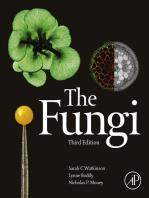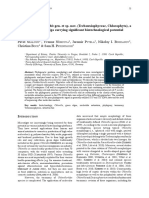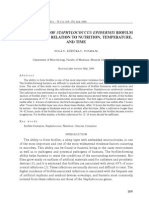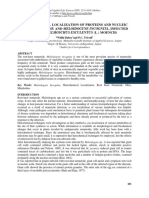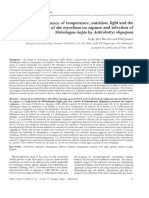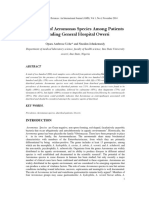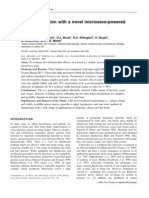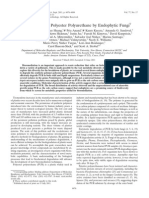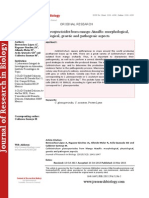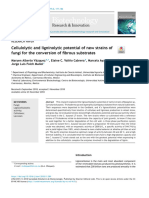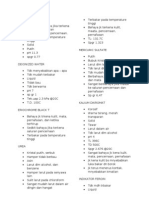Professional Documents
Culture Documents
An Endophytic Nodulisporium Sp. Producing Volatile Organic Compounds Having Bioactivity and Fuel Potential
Uploaded by
Izza Cahya KamilaOriginal Title
Copyright
Available Formats
Share this document
Did you find this document useful?
Is this content inappropriate?
Report this DocumentCopyright:
Available Formats
An Endophytic Nodulisporium Sp. Producing Volatile Organic Compounds Having Bioactivity and Fuel Potential
Uploaded by
Izza Cahya KamilaCopyright:
Available Formats
Izza Cahya Kamila 125061100111027 Chemical Engineering A 2012
An Endophytic Nodulisporium sp. Producing Volatile Organic Compounds Having Bioactivity and Fuel Potential
Endophytic microorganism are found in nature as they occupy the interstitial places of plant tissues and cause no apparent symptoms of their presence in the plant. The relation between microbe and plant can vary from symbiotic to borderline pathogenic. When the endophytic microorganism needs nutritive sources, the host plant offer it. Its contribution, may be one of the tissue protection generated of its own anti-pest metabolites. In fact, a lot of antibiotics have been isolated from various endophytic microbes. To date, the new endophytic fungus have been described as Muscodor sp. The search has been broadened to include many endophytic microorganism that may have potential to become biological control agent and potential fuel producers. The interest is, without the spectrum of volatile compound which made from each endophytic is to find one or more volatile compound that associate with the major classes of volatiles that are present in petroleum distillate fuels. These include the linear and branched chained alkanes. Thus, this report discuss about an endophytic fungus that produces highly desirable volatile metabolites. The endophytic fungus described in this report is Nodulisporium sp. having the most likely perfect stage being Daldinia eschscholzii (EC-12). A search for a new endophytic that produce VOC was conducted in the Napo river region of the upper Amazon in Ecuador. At least 20 plants were obtained by clipping terminal stem pieces from readily accessible portions of sample trees. The harvested specimens weere kept cool and the stem were treated and internal tissues pieces were set out on plates of water agar (WA) and glycerol-arginine medium (GAM). The tissue pieces were incubated at room temperature for several days. Visible fungal growth from the tissue samples were picked as hyphal tips and sub-cultured and transferred to potato dextrose agar (PDA) plates. An endophyte of interest was designated EC-12. The morphological data from EC-12 was acquired from Scanning Electron Microscopy process. The fungus was grown on -irradiated carnation leaves for 3 weeks and then the samples were slowly dehidrated in ethanol. The analysis of EC-12 was carried out by the acquisition of the ITS (Internal Transcribed Spacer)-5.8 S ribosomal gene scene. ITS regions of the fungus were amplified with the universal ITS primers ITS1 (5 TCCGTAGGTGAACCTGCGG 3) and ITS4 (5 TCCTCCGCTTATTGATATGC 3) using the polymerase chain reaction (PCR) that have been processed. Furthermore, the amplified product, was visualized and sequenced. To obtain the quantitative weight measurements on the VOC and also to learn what VOCs are made under conditions of near optimum aeration, the endophytes was grown in 7L of PD broth in a 10L flask for 14days at 22C. The flask outlet was connected to a custom designed stainless steel column containing Carbotrap materials specifically designed for trapping hydrocarbons aandd hydrocarbon derivatives. The compounds in the carbotrap column were desorbed by heating in a programmable oven, purged with a flow nitrogen gas, followed by passage of the effluent in a tube cooled with liquid nitrogen. From the process, the efficiency of the column trapping method ranges from 65-70% efficient.
Izza Cahya Kamila 125061100111027 Chemical Engineering A 2012 The volatiles produced by 13 days old culture of EC-12 were tested for antimicrobial activity against selected pathogenic fungi. The assays were conducted by growing the test organism on half side of a petri plate and then placing a small plug of each test fungus on the another side of the plate. Then the plate wrapped with parafilm and incubated at 23C for varying time periods. Growth of the filamentous test fungi was quantitatively assessed by making multiple measurements of growth. On the other hand, the carbotrapped VOCs were found in the trapping tube and assayed according to the methods described by Strobel. The test mixture is transferred to a small plastic cup and placed in the center of a Petri plate surrounded by small plugs of test organism. The growth of the test organism measured after appropriate exposure times. To determine the composition of VOCs, the fungus was grown in 60 ml of PD broth for 7 days in a sealed 250 ml Erlenmeyer flask, with constant agitation at 22C. Gas analysis of the compounds desorbed from the stainless steel Carbotrap (trapping tube) was done on a preconditioned fiber for 5 min after the tube was gently warmed to a volatilize the trapped liquid. The endophytic organism EC-12, by light and scanning electron microscopy produced an imperfect stage resembling that of Nodulisporium sp. (Figure 1). The organism when grown on PDA (2 week old culture) produced whitish felt-like mycelia on the 4 cm perphery of the culture. The mycelium produced erect to suberect, branching conidiophores with slender conidiogenous cells attached in irregular to verticillate patterns. Evidence of successional budding was seen as bud scars on conidiogenous cells (Figure 1). In all respects the fungus totally resembled Nodulisporium sp. However, the18S-ITS5.8S of the organism showed 99% sequence similarity with Daldinia escholzii which is the most likely the perfect stage for this organism even though it was never observed and D. escholzii has Nodulisporium sp. as its imperfect stage (Figure 2).
Izza Cahya Kamila 125061100111027 Chemical Engineering A 2012
The potential fuel compounds that could be consistently matched, in repeated experiments and on a qualitative basis, were 1,4-cyclohexadiene, 1-methyl-, 1-4 pentadiene and cyclohexene, 1-methyl-4-(1-methylethenyl)-, but other volatile compounds of interest were also produced (Table 1 in the journal). Interestingly, the cyclohexanes as well as pentane and its derivatives constitute some of the major groups of hydrocarbons in diesel fuels as analyzed by the SPME technique (Strobel, unpublished). However, the compounds in greatest abundance in the fungal VOCs were 1-butanol-3 methyl (and or 1 pentanol), and phenylethyl alcohol which also have fuel potential (Table 1 in the journal). Also, present in the analysis were a series of terpenoids including naphthene and azulene derivatives (Table 1 in the journal). In the other hands, the SPME-GC/MS analysis of the VOCs trapped by the Carbotraps yielded a plethora of hydrocarbon derivatives (as we see on Table 2 in the journal). Again, the most abundant substances detected were phenylethyl alcohol and 1-butanol-3-methyl which is comparable to that found in the smaller flasks (Table 2 in the journal). Also, it appears that the most, but not all of the compounds present in the trapping tube could detected and identified by this method (Table 2 in the journal). Andd since Nodulisporium sp. was making a plethora of VOCs it was deemed important to determine the biological role of these gases. A simple split plate test was done on 13 day old cultures of Nodulisporium sp. The results showed that the VOCs of the fungus were active against a wide range of plant pathogenic fungi (Table 3 in the journal). This is probably the case since many of the VOCs reported for M.albus are not present in Nodulisporium sp. and vice versa (Tables 1 and 2 in the journal). Finally, since the VOCs of Nodulisporium sp. could be recovered by the Carbotrap technology, they too were subjected to a bioassay test utilizing several select plant pathogens (Table 4 in the journal) and we have to know that the biological activity of the VOCs of this fungus is quite interesting given the fact that it express so much selectively. It would appear that this kind of testing should be done in future studies involving fungi making biologically active VOCs.
You might also like
- Aflatoxins Lab 1Document10 pagesAflatoxins Lab 1Thoriso Reginald MokgatleNo ratings yet
- In Vitro Cultivation of Callus Cells From Nodes and Internodes of Capsicum Annuum Cv. All BigDocument4 pagesIn Vitro Cultivation of Callus Cells From Nodes and Internodes of Capsicum Annuum Cv. All BigIJAERS JOURNALNo ratings yet
- Jimb 0113Document11 pagesJimb 0113Rosangel Gallardo RdguezNo ratings yet
- Isolation, Characterization, and Annotation: The Search For Novel Bacteriophage GenomesDocument9 pagesIsolation, Characterization, and Annotation: The Search For Novel Bacteriophage GenomeskeitabandoNo ratings yet
- Prepared By: Ken Robin A. Canada, RMT, Mls AscpiDocument35 pagesPrepared By: Ken Robin A. Canada, RMT, Mls AscpiKen Robin CanadaNo ratings yet
- Chavant2004 PDFDocument8 pagesChavant2004 PDFValentin GhenceaNo ratings yet
- Kjer, 2009 Methods For Isolation of Marine-Derived Endophytic Fungi and Their Bioactive Secondary ProductsDocument14 pagesKjer, 2009 Methods For Isolation of Marine-Derived Endophytic Fungi and Their Bioactive Secondary ProductsMinhHợi100% (2)
- Microbiological Quality Assessment of A Compost Produced From Animal Waste and VegetablesDocument11 pagesMicrobiological Quality Assessment of A Compost Produced From Animal Waste and Vegetablesjuan carlos CaicedoNo ratings yet
- 2014 Skaloud Et Al PlanktochlorellaDocument10 pages2014 Skaloud Et Al Planktochlorellanita prmtasariNo ratings yet
- Full Lab Report 1 - Endospore StainingDocument5 pagesFull Lab Report 1 - Endospore Stainingapi-557854804No ratings yet
- Vital Staining of Fungi in Pure CulturesDocument5 pagesVital Staining of Fungi in Pure CulturesBrianNo ratings yet
- Stemphylium Leaf Spot of Parsley in California Caused by Stemphylium VesicariumDocument8 pagesStemphylium Leaf Spot of Parsley in California Caused by Stemphylium VesicariumJohan Sebastián Ríos ZNo ratings yet
- The Dynamics of Staphylococcus Epidermis Biofilm Formation in Relation To Nutrition, Temperature, and TimeDocument6 pagesThe Dynamics of Staphylococcus Epidermis Biofilm Formation in Relation To Nutrition, Temperature, and TimeMohamed Amine MekniNo ratings yet
- Acid Other MusDocument9 pagesAcid Other MusRoberto CastellanosNo ratings yet
- Antifungal Potential of Extracellular Metabolites Produced by StreptomyDocument8 pagesAntifungal Potential of Extracellular Metabolites Produced by Streptomysiddhipurohit134586No ratings yet
- 54-Widhi Histochemical AcidsDocument10 pages54-Widhi Histochemical AcidsThiruselvam B PositiveNo ratings yet
- Name: Febiyani Ndaru Ratishiwi NIM: 10/297703/BI/08391 Example of Abstract From InternetDocument7 pagesName: Febiyani Ndaru Ratishiwi NIM: 10/297703/BI/08391 Example of Abstract From InternetFebiyan AnfNo ratings yet
- Flavescence DoreeDocument18 pagesFlavescence Doreebrkica2011No ratings yet
- Mycotoxin - CladosporiumDocument10 pagesMycotoxin - CladosporiumLe Kim Khoi PhiNo ratings yet
- Degradation and Fermentation of Cellulose by The RumenDocument6 pagesDegradation and Fermentation of Cellulose by The RumenSokchea VongNo ratings yet
- 1 s2.0 S2405844019305973 MainDocument7 pages1 s2.0 S2405844019305973 MainHelen WeldemichaelNo ratings yet
- Toltrazuril (Baycox) Treatment Against Coccidiosis Caused by Eimeria Sp. in Japanese Quails (Coturnix Coturnix Japonica)Document4 pagesToltrazuril (Baycox) Treatment Against Coccidiosis Caused by Eimeria Sp. in Japanese Quails (Coturnix Coturnix Japonica)khaled piksouNo ratings yet
- Pichia Anomala J121 During Airtight Storage of Wheat: Nutrient Effects On Biocontrol of Penicillium Roqueforti byDocument5 pagesPichia Anomala J121 During Airtight Storage of Wheat: Nutrient Effects On Biocontrol of Penicillium Roqueforti byNurul FuadyNo ratings yet
- Urn Cambridge - Org Id Binary 20170213065555240-0185 S0028646X99003652 S0028646X9900365XaDocument14 pagesUrn Cambridge - Org Id Binary 20170213065555240-0185 S0028646X99003652 S0028646X9900365XaPini KomalasariNo ratings yet
- 2 MycopathDocument6 pages2 MycopathPangeran Kelinci ßNo ratings yet
- 2018 Mendoza MoralesetalDocument9 pages2018 Mendoza Moralesetallucia mendozaNo ratings yet
- AsianJBiolLifeSci 1-2-83Document7 pagesAsianJBiolLifeSci 1-2-83Uriel StraussNo ratings yet
- Media Preparation, Isolation of Pure Culture and Bacterial GrowthDocument6 pagesMedia Preparation, Isolation of Pure Culture and Bacterial Growthhamody662002No ratings yet
- Evaluation of Biological Activity of Uncaria Tomen PDFDocument7 pagesEvaluation of Biological Activity of Uncaria Tomen PDFJoseph PositivoNo ratings yet
- The Influence of Temperature, Nutrition, Light and The Growth Time of The Mycelium On Capture and Infection ofDocument10 pagesThe Influence of Temperature, Nutrition, Light and The Growth Time of The Mycelium On Capture and Infection ofraid bazizNo ratings yet
- Harnessing Endophytes For Industrial Microbiology: Gary StrobelDocument5 pagesHarnessing Endophytes For Industrial Microbiology: Gary StrobelMEGA CAROLINA PUTRINo ratings yet
- Introduction To Biochemical Engineering: Assignment #1: Enzyme KineticsDocument10 pagesIntroduction To Biochemical Engineering: Assignment #1: Enzyme KineticsMatewos SadaNo ratings yet
- 2014 Prevalence of Aeromonas Species Among Patients Attending General Hospital OwerriDocument10 pages2014 Prevalence of Aeromonas Species Among Patients Attending General Hospital OwerriJOHNKENNEDY NNODIMNo ratings yet
- Ultraviolet Disinfection With A Novel Microwave-Powered DeviceDocument9 pagesUltraviolet Disinfection With A Novel Microwave-Powered Devicebarby17_2005No ratings yet
- Apb 4 599Document7 pagesApb 4 599indra maulanaNo ratings yet
- Candidatus Odyssella Thessalonicensis ' Gen. Nov., Sp. Nov., An Obligate Intracellular Parasite of Acanthamoeba SpeciesDocument10 pagesCandidatus Odyssella Thessalonicensis ' Gen. Nov., Sp. Nov., An Obligate Intracellular Parasite of Acanthamoeba SpeciessomasushmaNo ratings yet
- 2020 Velazquez-Dominguez Memorias OC Antigiardia KPDocument8 pages2020 Velazquez-Dominguez Memorias OC Antigiardia KPSarahi RiveraNo ratings yet
- Anti-Candida Albicans Effect of The Protein-Carbohydrate Fraction Obtained From The Coelomic Fluid of Earthworm DendrobaenaDocument30 pagesAnti-Candida Albicans Effect of The Protein-Carbohydrate Fraction Obtained From The Coelomic Fluid of Earthworm DendrobaenagtemizsoyNo ratings yet
- Project 1 Micro.-2Document7 pagesProject 1 Micro.-2NkosinathiNo ratings yet
- Biodegradation of Polyester Polyurethane by Endophytic FungiDocument9 pagesBiodegradation of Polyester Polyurethane by Endophytic FungiJuan Pablo Unfried HuertasNo ratings yet
- Paper 3Document4 pagesPaper 3IJARBS JOURNALNo ratings yet
- 15.isca Irjbs 2014 179 PDFDocument4 pages15.isca Irjbs 2014 179 PDFPutri Siti HawaNo ratings yet
- Full2005 10Document8 pagesFull2005 10Ariana ChimiNo ratings yet
- Colletotrichum Gloeosporioides From Mango Ataulfo: Morphological, Physiological, Genetic and Pathogenic AspectsDocument7 pagesColletotrichum Gloeosporioides From Mango Ataulfo: Morphological, Physiological, Genetic and Pathogenic AspectsresearchinbiologyNo ratings yet
- Microbiology-Microbial GrowthDocument8 pagesMicrobiology-Microbial GrowthViAn100% (2)
- 2 PB PDFDocument9 pages2 PB PDFmuh. saanNo ratings yet
- Human Monocyte Response To Andean-Native Starch NanoparticlesDocument8 pagesHuman Monocyte Response To Andean-Native Starch NanoparticlesSol AngelNo ratings yet
- JPAM Vol 15 Issue1 P 232-239Document8 pagesJPAM Vol 15 Issue1 P 232-239Jefri Nur HidayatNo ratings yet
- Lab 8 Endospore Stain and Gram StainDocument8 pagesLab 8 Endospore Stain and Gram StainAlyssa FerenceNo ratings yet
- (KARB2) (INT) Journal of Iodine StudyDocument6 pages(KARB2) (INT) Journal of Iodine StudyEdgard Fawwaz MuhammadNo ratings yet
- 1 s2.0 S2452072118300686 MainDocument10 pages1 s2.0 S2452072118300686 MainkhanNo ratings yet
- Skowron2018 Article ComparisonOfSelectedDisinfectaDocument11 pagesSkowron2018 Article ComparisonOfSelectedDisinfectaFlorentina BucurNo ratings yet
- Regeneration of Escherichia Coli Giant Protoplasts To Their Original FormDocument10 pagesRegeneration of Escherichia Coli Giant Protoplasts To Their Original FormPuja AgestiNo ratings yet
- EnumerationandidentificationofentericandpseudomonadDocument15 pagesEnumerationandidentificationofentericandpseudomonadHafsaAliNo ratings yet
- Introduction To MicrobiologyDocument55 pagesIntroduction To MicrobiologyAngelica Valdez BalmesNo ratings yet
- Challyspongia Sp.Document10 pagesChallyspongia Sp.Muh. Ade ArtasastaNo ratings yet
- Biochemical Tests ReportDocument12 pagesBiochemical Tests ReportExtra AccountNo ratings yet
- Degradation Kraft Indulin Lignin by Viridosporus Streptomyces BadiusDocument7 pagesDegradation Kraft Indulin Lignin by Viridosporus Streptomyces BadiusMuhammad UmerNo ratings yet
- PleszczyÅ Ska2013 Article SuccessfulLarge-scaleProductioDocument6 pagesPleszczyÅ Ska2013 Article SuccessfulLarge-scaleProductioJosé Manuel MejíaNo ratings yet
- Cara Goal and Seek TRKDocument2 pagesCara Goal and Seek TRKIzza Cahya KamilaNo ratings yet
- Starter Resistor PrimerDocument3 pagesStarter Resistor PrimerIzza Cahya KamilaNo ratings yet
- Turbidity Meters: About Us Pool Environment SupportDocument2 pagesTurbidity Meters: About Us Pool Environment SupportIzza Cahya KamilaNo ratings yet
- Ringkas Safety MaterialDocument2 pagesRingkas Safety MaterialIzza Cahya KamilaNo ratings yet
- Unsaturated Polyester Resins: Influence of The Styrene Concentration On The Miscibility and Mechanical PropertiesDocument5 pagesUnsaturated Polyester Resins: Influence of The Styrene Concentration On The Miscibility and Mechanical PropertiesMamoon ShahidNo ratings yet
- Nguyễn Thị Ngọc Huyền - 19125516 - Homework 3Document7 pagesNguyễn Thị Ngọc Huyền - 19125516 - Homework 3Nguyễn HuyềnNo ratings yet
- CV AmosDocument4 pagesCV Amoscharity busoloNo ratings yet
- Osteoporosis: Prepared By: Md. Giash Uddin Lecturer, Dept. of Pharmacy University of ChittagongDocument30 pagesOsteoporosis: Prepared By: Md. Giash Uddin Lecturer, Dept. of Pharmacy University of Chittagongsamiul bashirNo ratings yet
- Engineering Road Note 9 - May 2012 - Uploaded To Main Roads Web SiteDocument52 pagesEngineering Road Note 9 - May 2012 - Uploaded To Main Roads Web SiteRahma SariNo ratings yet
- Flow ChemistryDocument6 pagesFlow Chemistryrr1819No ratings yet
- Su Jok, Twist Therapy AND Smile MeditationDocument7 pagesSu Jok, Twist Therapy AND Smile MeditationprateekNo ratings yet
- Improving Self-Esteem - 08 - Developing Balanced Core BeliefsDocument12 pagesImproving Self-Esteem - 08 - Developing Balanced Core BeliefsJag KaleyNo ratings yet
- Tool Stack Template 2013Document15 pagesTool Stack Template 2013strganeshkumarNo ratings yet
- Dopamine What It Is, Function & SymptomsDocument7 pagesDopamine What It Is, Function & SymptomsRaj KumarNo ratings yet
- Software Project Management PDFDocument125 pagesSoftware Project Management PDFUmirNo ratings yet
- 1929 Davos DisputationDocument20 pages1929 Davos DisputationEstevao Cruz100% (1)
- Bossa Nova Book PDFDocument5 pagesBossa Nova Book PDFschmimiNo ratings yet
- Isc The Tempest Workbook Answers Act 1 Scene 2: Home Science Commerce Mathematics Language LiteratureDocument31 pagesIsc The Tempest Workbook Answers Act 1 Scene 2: Home Science Commerce Mathematics Language LiteratureHarsh Ahirwar100% (1)
- Ogayon Vs PeopleDocument7 pagesOgayon Vs PeopleKate CalansinginNo ratings yet
- IUGRDocument4 pagesIUGRMichael Spica RampangileiNo ratings yet
- Saptamsa - D7Document4 pagesSaptamsa - D7Nabeel IrfanNo ratings yet
- Case - Marico SCMDocument26 pagesCase - Marico SCMChandan Gupta50% (2)
- Class 12 Accountancy HHDocument58 pagesClass 12 Accountancy HHkomal barotNo ratings yet
- E 18 - 02 - Rte4ltay PDFDocument16 pagesE 18 - 02 - Rte4ltay PDFvinoth kumar SanthanamNo ratings yet
- Activity Chapter1 ManagementDocument7 pagesActivity Chapter1 ManagementTricia Amigo SacareNo ratings yet
- Roman Villas at Tor Marancia and CentocelleDocument10 pagesRoman Villas at Tor Marancia and CentocelleIgor ĆirkovićNo ratings yet
- BSCHMCTT 101Document308 pagesBSCHMCTT 101JITTUNo ratings yet
- Thesis Committee MeetingDocument7 pagesThesis Committee Meetingafknojbcf100% (2)
- Answers To Case Studies 1a - 2dDocument9 pagesAnswers To Case Studies 1a - 2dOgnen GaleskiNo ratings yet
- Polynomials Level 3Document17 pagesPolynomials Level 3greycouncilNo ratings yet
- RPT Form 2 2023Document7 pagesRPT Form 2 2023NOREEN BINTI DOASA KPM-GuruNo ratings yet
- MISKDocument134 pagesMISKmusyokaNo ratings yet
- Aroma TherapyDocument89 pagesAroma TherapyHemanth Kumar G0% (1)
- Defending A Dogma: Between Grice, Strawson and Quine: Elvis ImafidonDocument10 pagesDefending A Dogma: Between Grice, Strawson and Quine: Elvis ImafidonYang Wen-LiNo ratings yet
